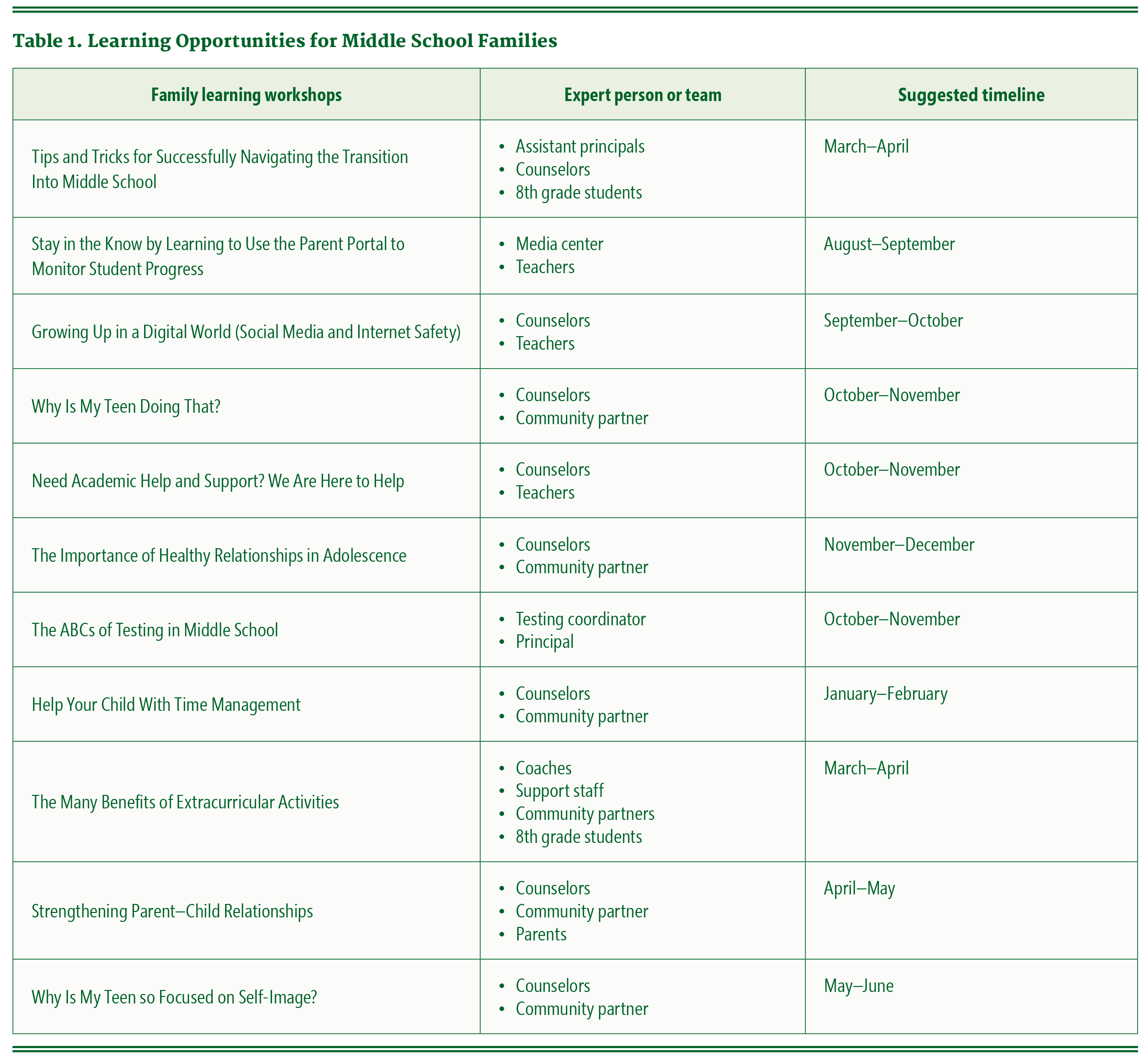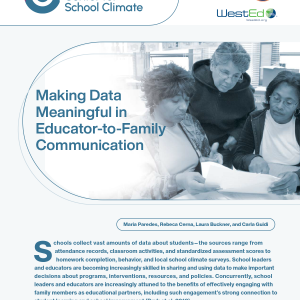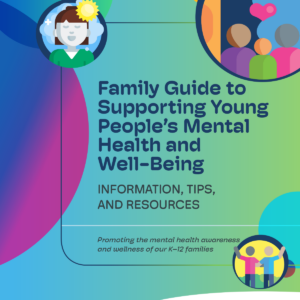Strengthening Home and School Connections in the Middle School Years
Posted on

This article is written by Maria Paredes, Senior Engagement Manager for Family and Community Engagement at WestEd and first appeared in the Leadership for Educational Achievement Foundation (LEAF), Volume 9, Issue 1 subscription newsletter and is published here with permission. LEAF serves as the professional development arm of the New York State Council of School Superintendents.
The transition from elementary to middle school is often marked by wariness and uncertainty for students and their families. Early adolescence and socialization into middle school bring about big changes on many levels. For students, this period coincides with cognitive growth, biological development, and social and emotional development. In addition, entering middle school students must contend with changes in school context and curriculum and with higher academic expectations from teachers and families. The combination of so many changes and stressors on students often leads to academic performance decline while the long-term implications of academic performance increase (Hill & Tyson, 2009).
Exacerbating the challenges that come with the transition from elementary to middle school is the decline in family engagement that also often occurs. In the elementary grades, families are encouraged to be engaged and often receive concrete information, tips, and strategies that help them monitor and support learning. They also enjoy many opportunities to interact with teachers and other families and are kept informed of changes and developments in their child’s learning and behavior. These interactions and exposure strengthen families’ knowledge about the curriculum, increase social capital, and help them become better equipped to monitor and support learning at home. Then comes the sharp contrast experienced by families as their child enters middle school. In the words of many families, everything goes quiet and dark. The fact is that middle school families are eager for information and support that can help them navigate the transition into middle school and adolescent development changes, and they want to know about age-appropriate ways to engage and support academic achievement.
The Role of Educational Leaders in Support of Healthy Transitions
Given the significant adjustments new middle schoolers and their families face, it is imperative that educational leaders work with parents to ensure healthy transitions. In fact, academic socialization has been identified by research as the most effective form of family engagement that leads to higher student achievement. Academic socialization includes parents communicating high expectations, valuing education, fostering educational and occupational aspirations, discussing learning strate- gies, and making preparations and plans for the future (Hill & Tyson, 2009). It is during adolescence that goals, beliefs, and motivations are internalized and such inner processes shape adolescents’ academic performance and course selection (Wigfield et al., 2006).
What Educational Leaders Can Do to Support Families of Middle School Students
Compared to many elementary schools, middle schools are often larger and more complex institutions where teachers instruct larger numbers of students. These conditions make it challenging for teachers and families to develop collaborative relationships. Nonetheless, families of students entering middle school need to feel informed about, included in, and connected to their child’s learning and educational goals.
The following are four effective practices and strategies that district and school leaders can use to help strengthen families’ knowledge, skills, and strategies to support learning, as well as to help middle school educators to develop the capacity and disposition to partner with families in ways that are streamlined.
- Open Two-Way Lines of Communication. A key practice for educational leaders is to share information with families before, during, and after the transition into middle school and to use multiple channels of communication to reach every family. For example, leaders can send an early spring bulletin to families with students who are just finishing elementary school, and the bulletin can clearly walk families through the details of the transition into middle school. Links can be included for families to provide feedback and post questions. Leaders can also share the same information through a webinar, record it, and post it on the school’s website and other media channels. The goal is to communicate proactively, anticipate the questions and concerns that families may have, and have the school staff acknowledge families and engage them as equal partners.Leaders can also coordinate and/or cosponsor a middle school transition event for families with feeder elementary schools. Such events can be used as an opportunity to clearly communicate the expectations of families and new students and to share the many resources available to support them through the transition period.
- Develop Staff Capacity and Dispositions to Support Families. Developing staff capacity involves learning new skills and abilities from experts in the field. It also involves developing or strength- ening healthy core beliefs about families, which is necessary for enabling educators to recognize and remove barriers that stand in the way of families fully participating in their children’s education. District leaders can build the capacity of their school leaders and staff through a variety of strategies and supports, including coaching, mentoring, professional learning, and technical assistance. These capacity-building supports can help educators understand why it is important to work with families and to value families’ perspectives and experiences.It is important to keep in mind that learning and skill-development opportunities that are offered to educators must continually evolve and improve from one year to the next through incorporating new research developments in the field and reflecting the internal evidence and experience of what is working well in middle schools. Results from yearly needs assessments contribute to this body of knowledge that can inform the capacity-development opportunities (Paredes, 2022).
- Develop Family Capacity to Support Student Academic and Social–Emotional Success. Another effective strategy for engaging families is to offer parents and families opportunities for learning from school and community experts and to create spaces where they can network with other families to strengthen social capital. Consider conducting a yearly needs assessment to inform what families are interested in learning. The results from the needs assessment can guide the school and district in selecting expert speakers to facilitate workshops or learning groups. Speakers can be teachers, counselors, school leaders, family members, business leaders, and college or university partners.To improve home and school connections, it is important that families recognize schools as places for learning, collaborating, and networking not only for students but also for families. Organized learning opportunities increase relationships and trust between educators and families and strengthen families’ skills and knowledge to support their children.The family’s role in the elementary years is that of co-teacher, whereas in the middle school years the family’s role shifts to that of coach. Families can better navigate and fulfill this evolving role with support from school- and community-sponsored learning opportunities.
- Leverage Advisory Periods in Middle School. Many schools have advisory periods in which teachers regularly meet with small cadres of students. If these do not exist in your middle schools, consider building them into the schedule. Where they exist, middle school teachers can meet the family engagement challenge by expanding the focus of advisory groups to include the students’ families. By focusing on the subgroup of students they advise, engaging their families becomes more manageable. Their engage- ment efforts can include conducting some home visits, developing trusting relationships with families, being a school point of contact, and codesigning student success plans. This approach creates a much- needed two-way communication lifeline between home and school.
The fact is that middle school families are eager for information and support that can help them navigate the transition into middle school and adolescent development changes, and they want to know about age-appropriate ways to engage and support academic achievement.
Create a System for Scheduling Family Learning Opportunities
Another effective tactic for enhancing family engagement is to create and disseminate a yearly calendar featuring family learning opportunities. For each opportunity on the calendar, highlight the topic, the purpose, and the expert speaker(s), and describe what families will learn and be able to apply. Having access to a yearly calendar allows families to identify high-interest events and helps them plan ahead. The family learning calendar can be sent through the mail and posted on the school website, on social media, and by the front office so office staff are informed and can answer families’ questions if they call or stop by.
Bear in mind that less is more. Be strategic. Parents and families are very busy people with a lot of responsibilities. When planning the yearly learning events, prioritize events and activities that are of high interest to families, and integrate those events with other popular and highly established events, such as Open House and Career Day. Create consistency by scheduling family learning events during the same months and times each year, and feature learning topics that help families when they need it most.
Table 1 (below) lists a series of learning opportunities for families with middle schoolers. The workshops can be offered during different times of the year and can be facilitated by school staff and community partners. Sometimes family members can also be included as support families with information and partners or co-facilitators. The goal is to strategies they can apply right away and to offer them the time and space to build supportive networks with other families.
(Click the image below to download a PDF of the Learning Opportunities for Middle School Families chart.)

These workshop topics represent just a few of many that families may be interested in learning about and dis- cussing with subject matter experts and other families. You might have families complete a poll that ranks the workshop topics from most to least important and asks them to add relevant topics missing from the list. You should also recruit families to get involved with planning and organizing these learning events and securing expert presenters.
Conclusion
The four strategies highlighted in this article are designed for educational leaders to strengthen home and school connections during the transition into middle school and through the middle school years. The strategies can be used as a framework to support improved home and school two-way communica- tion; to equip educators and families with skills, knowledge, and dispositions for partnerships through professional learning opportunities and family workshops; and to offer an alternative approach to advisory periods that can positively impact student achievement through family engagement that is aligned with the middle school context.
Application of these strategies in schools can help create collaborative connections between educators and families and give families a voice and the space and opportunity to grow as coaches to support student academic improvement and well-being.
References
Hill, N. E., & Tyson, D. F. (2009). Parent involvement in middle school: A meta- analytic assessment of the strategies that promote achievement. Duke University.
Paredes, M. (2022). A systems approach to planning a rewarding family engagement experience. WestEd.
Wigfield, A., Byrnes, J. P., & Eccles, J. S. (2006). Development during early and middle adolescence. In P. A. Alexander & P. H. Winne (Eds.), Handbook of educational psychology (2nd ed., pp. 87–113). Erlbaum.
Resources
- Family Engagement Toolkit: Continuous Improvement Through an Equity Lens
https://w w w.cde.ca.gov/fg/aa/lc/ documents/family-engagement.pdf - The Dual Capacity-Building Framework for Family–School Partnerships https://www.dualcapacity.org/
- Family Engagement Reimagined (from the Christensen Institute) https://www.christenseninstitute.org/publications/family- engagement-reimagined/
 Maria Paredes is dedicated to excellence and equity in family engagement. She works to tear down walls between home and school and helps educators and families join forces as genuine partners for learning. Her areas of expertise include family and community engagement, organizational development, needs assessments, and design of high-impact family engagement programs for state departments, districts, and schools.
Maria Paredes is dedicated to excellence and equity in family engagement. She works to tear down walls between home and school and helps educators and families join forces as genuine partners for learning. Her areas of expertise include family and community engagement, organizational development, needs assessments, and design of high-impact family engagement programs for state departments, districts, and schools.


